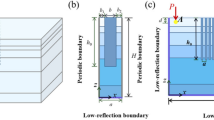Abstract
Soil layering has a pivotal role on the behavior and propagation of seismic waves, hence the ground response during seismic loading. Parametric study to estimate the effect of soil layering on ground response parameters is of prime importance considering the engineering significance of structure founded in seismic zone; nonetheless, it is yet to be well understood. The objective of this study was to investigate the effect of soil layering and soil properties on the ground response parameters. One-dimensional linear ground response analysis was conducted with variation in soil layer parameters including impedance ratio (α z ), layer thickness (d r ), and damping ratio (D). The acceleration time history of the Bhuj Earthquake (M w = 7.7), India, was used in the analysis. The results obtained from the analysis were presented as variation of ground response parameters such as spectral acceleration (SA), amplification ratio (M) with the soil layer parameters. Results showed higher values of SA at lower D and then decreased with increase in D, that in fact depict the resistance offered to the particle oscillation at comparatively higher values of D. Similarly, variation in SA and M was very less or negligible when the α z was varied from 1 to 3 and the d r equal to 0.2, while for d r greater than 0.2 the variation increased with α z and d r . The outcome from the parametric study presented in this paper clearly demonstrates the significance of α z , D, and d r of the soil layers on the ground response parameters.








Similar content being viewed by others
Abbreviations
- A :
-
Displacement amplitude
- α z :
-
Wave impedance ratio
- c b :
-
Coefficient of reflection at the layer boundary
- [C]:
-
Damping matrix
- D :
-
Damping ratio of the soil
- D rock :
-
Damping ratio of bed rock
- d 1 :
-
Thickness of layer 1
- d 2 :
-
Thickness of layer 2
- d r :
-
Thickness ratio
- f :
-
Frequency
- f n :
-
Natural frequency
- g :
-
Acceleration due to gravity
- ρ 1 :
-
Mass density of layer 1
- ρ 2 :
-
Mass density of layer 2
- {I}:
-
Unit vector
- [K]:
-
Stiffness matrix
- M :
-
Amplification ratio
- M w :
-
Earthquake moment magnitude
- [M]:
-
Mass matrix
- SA:
-
Spectral acceleration
- T :
-
Time period
- σ a :
-
Stress amplitude
- {\( \ddot{u}_{g} \)}:
-
Acceleration at the base of the soil
- {\( \ddot{u} \)}:
-
Vector of relative acceleration
- {\( \dot{u} \)}:
-
Vector of relative velocity
- {u}:
-
Vector of relative displacement
- v s1 :
-
Shear wave velocity of layer 1
- v s2 :
-
Shear wave velocity of layer 2
References
Govindaraju L, Ramana GV, HanumanthaRao C, Sitharam TG (2004) Site-specific ground response analysis. Curr Sci 87(10):1354–1362
Hashash YMA (2009) DEEPSOIL—user manual and tutorial. Version 3.7 Beta, University of Illinois
Hashash YMA, Park D (2001) Non-linear one-dimensional seismic ground motion propagation in the Mississippi embayment. Eng Geol 62(1–3):185–206
Hashash YMA, Park D (2002) Viscous damping formulation and high frequency motion propagation in nonlinear site response analysis. Soil Dyn Earthq Eng 22(7):611–624
Kausel E, Roesset JM, Waas G (1975) Dynamic analysis of footing on layered media. J Eng Mech Div ASCE 101(EM5):679–693
Nakamura N (2005) A practical method for estimating dynamic soil stiffness on surface of multi-layered soil. Earthq Eng Struct Dyn 34:1391–1406
Park D, Hashash YMA (2004) Soil damping formulation in nonlinear time domain site response analysis. J Earthq Eng 8(2):249–274
Sitharam TG, Govindaraju L (2004) Geotechnical aspects and ground response studies in Bhuj earthquake, India. Geotech Geo Eng 22(3):439–455
Sitharam TG, Srinivasa Murthy BR, Kolge A (2001) A post-mortem of the collapse of structures in Ahmedabad during the Bhuj earthquake. Proc Indian Geotech Conf 1:344–347
Tajimi H (1959) Basic theories on a seismic design of structures. Report Institute of Industrial Science, Tokyo University 8(4):170–215 (in Japanese)
Wong HL, Luco JE (1978) Tables of impedance functions for square foundations on layered media. Intl J Soil Dyn Earthq Eng 4(2):64–81
Acknowledgments
The author greatly acknowledges the help of Dr. Deepankar Choudhury, Associate Professor, Indian Institute of Technology Bombay, India, and Dr. Shahid Azam, Associate Professor, University of Regina, Canada, for their support and guidance during the study and preparation of the manuscript.
Author information
Authors and Affiliations
Corresponding author
Rights and permissions
About this article
Cite this article
Raghunandan, M.E. Effect of soil layering on the ground response parameters: a parametric study. Nat Hazards 63, 1115–1128 (2012). https://doi.org/10.1007/s11069-012-0208-3
Received:
Accepted:
Published:
Issue Date:
DOI: https://doi.org/10.1007/s11069-012-0208-3




